Sand Casting Defects

|
| Casting Defects |
Casting Defects Types
Types of casting defects can be classified into five types:
- Pouring Metal Defects.
- Moulding Material Defects.
- Shrinkage Defects.
- Metallurgical Defects.
- Gas Defects.
Above are the casting defects that occur in the final casting during various types of casting processes such as sand casting process, investment casting process, shell moulding process and die casting process.
Pouring Metal Defects
Slag Inclusions

|
| (a) Slag Inclusion Defect |
During the pouring operation metal ends up in a final casting without being filtered at the pouring basin is called slag inclusion.
Slag inclusions in the final casing are shown above in diagram (a).
When metal is taken out of the furnace it consists of slag, oxides, impurities and foreign material.
Flux is added to the molten metal and it becomes essential to remove any slag before pouring metal into the pouring basin.
Any slag present in the molten metal that solidifies in the casting weakens the casting and is not a good casting practice.
Many slag trapping methods are used in pouring basins such as skimmers and strainers to stop slag from entering the mould.
I have written a section about slag-trapping methods in a pouring basin article discussing how slag-trapping elements work.
The runner has a skim bob slag trapping element that stops slag from entering into the mould cavity.
Misrun
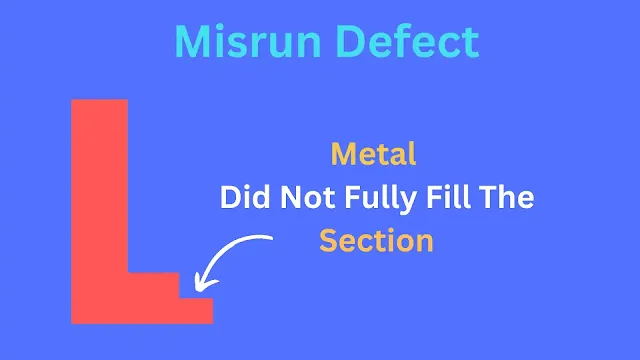
|
| (b) Misrun Defect |
Misrun is a pouring defect caused when metal is not able to fill the section of the mould cavity fully leaving the final casting incomplete.
This defect can occur when the temperature of the metal is low and the viscosity of molten metal reduces reducing fluidity.
Due to reducing the fluidity of molten metal, metal does not complete the section and solidifies beforehand as shown in the diagram below (b)
Final casting removed from the mould remains incomplete in sections where a misrun of molten metal takes place.
The remedy to avoid misrun is to maintain the temperature of molten metal to improve fluidity. The higher the temperature higher the rate at which metal flows.
Metal needs to be after the section is filled and not beforehand.
Provide sufficient feeding of molten metal to the sections by a riser and have a small surface area to volume ratio, especially in a green sand mould.
The worn-out patterns and cores need to be replaced regularly with new ones for proper impression and flow of metal in the cavity where metal is to be cast.
This defect is visible to the naked eye and can be clearly seen by a quality engineer.
Cold Shunt

|
| (c) Cold Shunt |
Cold shunt defect is caused when the fluidity of molten metal reduces and sections are solidified before they fuse/merge together.
The cold shunt is a visible defect to the eye and is similar to a misrun with the difference that molten metals do not join together to form one desirable section.
Cold shunt defect in casting is shown above in diagram (c)
The reduction in the flow of the molten metal due to gases being trapped because of insufficient venting is also a strong reason for the cold shunt defect.
Improper pouring and slow pouring cause metal to flow inconsistently in the mould sections.
At times pattern used to make cavities in the mould is incomplete along improper gating design gives rise to cold shunt.
The remedy for cold shunt defect is similar to a misrun.
Designing green sand mould with a good feeding system and maintaining the temperature of the molten metal during the flow.
Have a proper venting system that lets all gases escape allowing molten metal to flow smoothly in all sections of the mould.
Internal Air Pockets
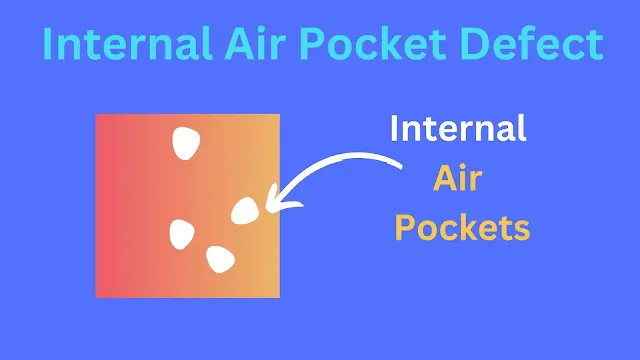
|
| (d) Internal Air Pocket Defect In Casting |
The pocket formed in casting when hot boiling molten metal is poured rapidly into the mould cavity is called an internal air pocket.
Internal air pocket defect formed in casting is shown above in diagram (d)
Air pocket depends upon the quality of molten metal, the quality of the mould, the pouring temperature and the moisture in it.
Warpage
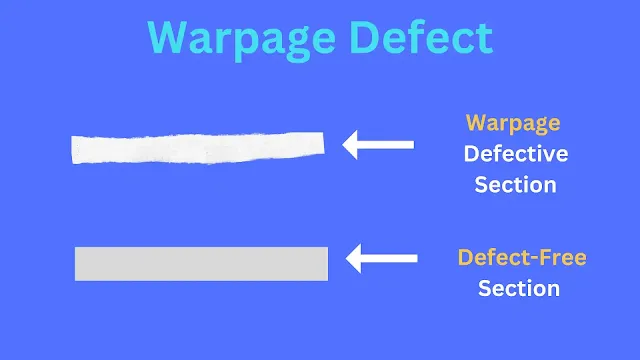
|
| (e) Warpage Casting Defect |
Warpage defect is caused by deformation during or after the solidification of casting.
Warpage takes place when two joint, large and thin sections of casting solidify but at different solidification rates.
Due to the un-uniform solidification casting distortion takes place due to stresses at the joints of the rip section.
The remedy to solve warpage defects is to give uniform solidification to the casting ribs which are larger in size.
Distortion allowance or warpage allowance is given to compensate for distortion/warpage defect.
Warpage or distortion defect in sand casting is shown above in diagram (e)
Poured Shot

|
| (f) Poured Shot Casting Defect |
When molten metal poured is insufficient to fill the mould cavity, the defect formed is called poured shot.
The amount of metal to be poured and temperature while pouring needs to be calculated beforehand to reduce this defect.
Metal is not only required for the cavity but also riser and shrinkage allowance should be considered.
The poured short casting defect is shown above in diagram (f)
Moulding Material Defects
Drop

|
| (g) Drop Casting Defect |
Drop defect is caused when mould sand cracks and falls into the mould cavity from the cope section of the mould.
Mould sand can drop just after the mould has been made or during the pouring operation.
This sand falling is in the form of lumps and is not desirable for final casting.
The drop moulding defect is shown above in diagram (g).
Ramming and bonding of sand should be strong enough to eliminate any sand falling in the mould cavity from the cope section.
In the green sand mould, there are higher chances of this defect as compared to moulds that are cured.
Scabs

|
| (h) Scabs Casting Defect |
When molten metal is poured the mould and core can get lifted if not rammed and placed properly.
Defects caused when molten metal enters below cores and mould and solidifies is called scab.
The texture of scabs is tin, irregular, and rough and can be visually inspected by a quality control engineer.
Scabs are caused by uneven ramming of fine sand, slow pouring, low binding of sand, low moisture content and permeability.
The scab casting defect is shown above in diagram (h).
The remedy for this defect is the use of additives such as wood flour, dextrin, carbon dust and sea coal to remove this defect.
Along with it maintaining pouring temperature, smooth flow of molten metal, not ramming mould very soft and a mould having sufficient venting to remove gasses so molten metal freely flows.
Dirt
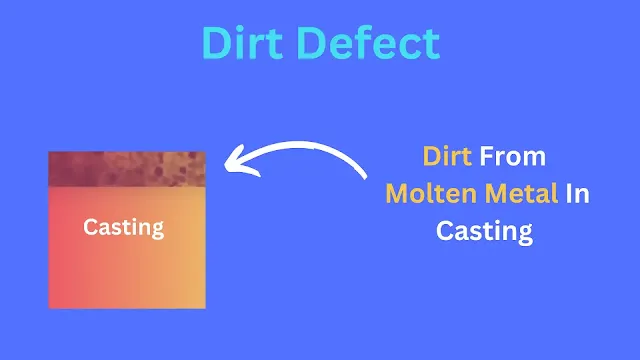
|
| (i) Dirt Casting Defect |
Due to improper skimming elements during the pouring operation molten metal that solidified consists of dirt.
The remedy to avoid this defect is to have proper skimming elements incorporated in the mould.
The dirt casting defect is shown above in diagram (i).
Honeycombing or Sponginess

|
| (j) Honeycombing or Sponginess Defect In Casting |
Honeycombing or sponginess is formed in the presence of dirt in the molten metal formed in clusters.
The difference between this and a dirt defect is that a honeycombing defect is nothing but a cluster of dirt and sponginess is made up of dirt only.
The honeycomb or sponginess casting defect is shown above in diagram (j).
Run Out

|
| (k) Run Out |
A run-out defect is caused when molten metal is leaked out of a green sand mould.
This may be caused due to bad sand moulding practice weakening the mould or faulty flask.
The remedy for eliminating run-out defects is following standard practices for making mould.
This defect will result in incomplete fail-casting.
The runout casting defect is shown above in diagram (k).
A strong cured dry mould having higher strength is immune to this defect.
Runout is visible and can be clearly seen. The casting process should be immediately stopped if the leakage is large.
Swell

|
| (l) Swell Defect |
When molten metal pushes the mould causing it to enlarge is called a swell defect.
Swelling is caused mainly when molten metal is not able to pass the riser properly due to resistance in the flow of molten metal.
Swelling defect reduces when molten metal passes smoothly through the sprue, runner, gate and then riser smoothly without any blockage reducing swell defect.
The swell casting defect is shown above in diagram (l).
The remedy for swelling is making mould compact by ramming.
Fusion

|
| (m) Fusion Defect |
Fusion defect is caused when molten metal fuses with the sand in the mould cavity.
This results in metal casting having a glassy appearance and brittle structure.
The main cause behind the fusion defect is the clay in the mould has of lower refractoriness property and the temperature of molten metal is too high.
Binding agents should be able to handle higher temperatures of molten metal, if sand fails to do that metal fuses to the sand.
The fusion casting defect in casting is shown above in diagram (m).
The remedy for fusion defect is using higher refractory property binders such as bentonite and keeping the temperature of molten metal appropriate.
Sand Holes

|
| (n) Fusion Casting Defect In Casting |
Sand hole defect is a type of mould defect seen after sandblasting the final casting.
Sandholes defects typically look like voids in the casting as shown above
in diagram (n).
Sand holes are formed when mould is not properly cleaned and metal is not poured properly.
Sand holes can be seen externally or internally in the final casting if loose sand gets washed out and fuses in the mould creating blisters.
Proper cleaning, maintenance and ramming of the mould eliminate the sand holes.
Metal Penetration

|
| (o) Metal Penetration |
Metal penetration is caused when molten penetrates the coarse sand in the mould. Penetration can also take place in the absence or insufficiency of the mould wash.
When mould wash is applied and sufficient molten metal comes in contact with molten metal gases are generated creating a shield between molten metal and sand not allowing the metal to penetrate the sand as shown above in the diagram (o).
Metal penetration defect is visible on the surface and can be easily identified as it gives an uneven rough texture to the final casting.
This defect is seen at the corner of casting and is caused by sand that is
burned allowing the metal to penetrate due to poor
refractoriness
and also burning the chemicals and washes.
The remedy for eliminating metal penetration defects is using a variety of grain sizes and shapes of sand along with sufficient moulding wash.
Other remedies are to reduce soft ramming and improve the strength of the mould and improve permeability by increasing grain size to reduce metal penetration of casting.
Cuts And Washes
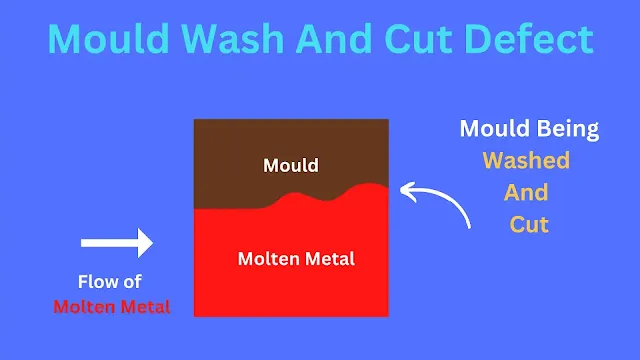
|
| (p) Mould Washes and Cut Casting Defect |
Cuts and wash defects are caused when molten at a higher velocity in a weak mould erodes sand in the mould.
Having a strong rammed mould with a good binding agent and with lower velocity will reduce cuts and wash defects.
Mould washes and cuts are shown above in diagram (p).
The mould should have enough strength to tolerate the flow of molten metal at a higher speed in all sections of the mould cavity.
Rat Tails

|
| (q) Metal Penetration Casting Defect |
When the molten metal has excess heat it will cause sand to expand leading mould to compress pushing the mould skin and causing rat tail defects and giving rat tail appearance.
This defect is caused due to compression failure of the mould and looks like a rat tail.
The molten metal having excess temperature is also an important factor causing rat tail defects.
A rat tail defect is also called a vein casting defect as it looks like one
as shown above in diagram (q).
The remedy to handle rat tail defects is to have mould sand with higher compressive strength properties.
Buckle
The buckle is a further extension of rat tails with more severity.
The remedy for rat tails and buckle defects is using facing sand having hot strength and expansion properties along with molten metal having sufficient heat required for the process.
Buckle defects are easily visible and can be felt on the casting surface.
Shift

|
| (r) Shift Casting Defect In Casting |
The shift is caused when mould, pattern and cores are not properly aligned resulting in a mismatch in the top and bottom parts of the casting.
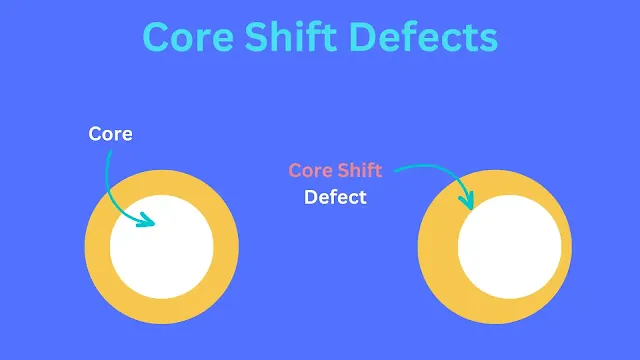
|
| (s) Core Shift Casting Defect |
This defect is mostly observed at the intersection of cope and drag at the parting line or due to the flask while making mould.
As the name suggests mould shifts from the desirable position causing shift defects shown above in diagram (r).
The remedy for shift defects is to practice standard practice while sand mould making.
Shown above in diagram (s) shift defect in the core.
Properly aligning pins while making a sand mould.
Make sure the pattern is properly placed and does not move during drag and cope-making operation and further while a mould is assembled.
Sift defects with higher tolerance margins cannot be corrected and casting has to be rejected.
Fin And Flash

|
| (t) Fin & Flash Casting Defect |
When molten metal is poured into the mould it is expected that metal does not come out where the mould is assembled (at cope and drag).
But when metlastic forces are higher in the mould metal pushes the cope upwards creating a space between cope and drag resulting in metal coming out at the parting line called fins.
This metal is a very thin protrusion and looks like a fin as shown above in diagram (t).
The remedy to reduce fin defect is keeping a heavy metal block on the cope not allowing the metal to come out of the intersection between the cope and drag.
Fin defects can be corrected by sandblasting for small fins and burr for bigger fins grinding removes all fins from the final casting.
Metallurgical Defects
Hot Tears Or Pulls

|
| (u) Hot Tear Casting Defect |
All sections of casting cannot have the same thickness.
If sections of casting have different thicknesses, one is thicker and the other is thinner the thinner will solidify first.
When the thicker section starts solidifying it induces stresses on the solidified tinner sections.
This stress developed on the solidified thinner sections results in tearing and is called a hot tear.
The hot tear can be defined as tears/cracks that are developed in the sections of casting due to differential cooling rate.
Shows above hot tears in the casting process in diagram (u).
Sharp turns and sudden changes in the section are prone to hot tears.
The remedy for hot tears is to design casting with smooth radii and eliminate any strong and sudden changes in the sections.
Unform solidification of all sections of casting is the primary requirement to eliminate hot tears and cracks in casting.
Sufficient chills and padding with the proper design of the gating system can be used to achieve directional solidification.
External cracks are visible while internal cracks require an x-ray for inspection.
Hot Spot

|
| (v) Hot Spot Casting Defect |
Hotspots are observed in casting sections with non-uniform thickness where the concentration of metal is highest.
As shown below L shape casting section, at the intersection of the two sections concentration and temperature of the metal are the highest and uniform thickness is the lowest.
This is an ideal spot for hotspot defect, at this point, molten metal soldiers last causing hot spots.
Shows the above hot spot in the casting in diagram (v).
The only remedy for this defect is designing casting with uniform thickness reducing the temperature spots where the concentration of metal takes place.
Uniform design and directional solidification of metal will eliminate any hotspots.
Gas Defects
Pinhole Porosity
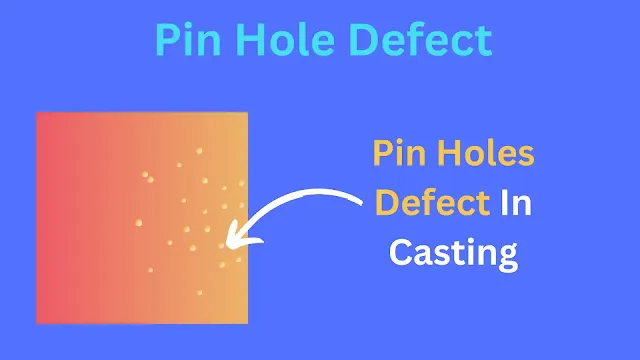
|
| (w) Pinhole Casting Defect |
Pinhole defect is caused because of hydrogen, moisture, and carbon monoxides present in the furnace, crucible and mould cavity.
Another reason for pinhole porosity defect is higher pouring temperature.
When molten metal starts losing its temperature gasses dissolved in it expelled from the molten metal.
During gasses being expelled from the molten metal leaves a pinhole-like structure in the casting.
Pinhole appearance is of small diameter but longer in length as shown above in diagram (w).
A series of pinholes can cause the casting to be weak and metal to leak from that section.
This defect is seen more in aluminium alloys such as steel-aluminium, iron-aluminium and other aluminium alloys.
The remedy to avoid pinhole defects is to use cured dry sand mould without moisture, remove any moisture in a ladle and soft ramming of mould for the easy escape of the gases.
Pinholes are normally seen on the surface of the casting but an ultrasonic
flow detector is used for detecting pinholes which are below the surface of
the casting.
Correction in this casting can be done by shot blasting.
Air Inclusions
Air inclusions are caused by gasses that are trapped in the molten metal in the furnace, ladle, in mould and during pouring operation that are not able to escape during the casting process.
Remedy for air inclusion defects is designing a sprue that reduces air aspiration, turbulence and vortex formation during the pouring operation, gases formed during the melting of molten metal in a furnace, a mould having less permeability property and improper ventilation.
Dry sand moulds and skin-dry sand moulds have lesser air inclusion defects.
This gas trapped in casting weakens the casting and needs to be removed beforehand.
Blowholes
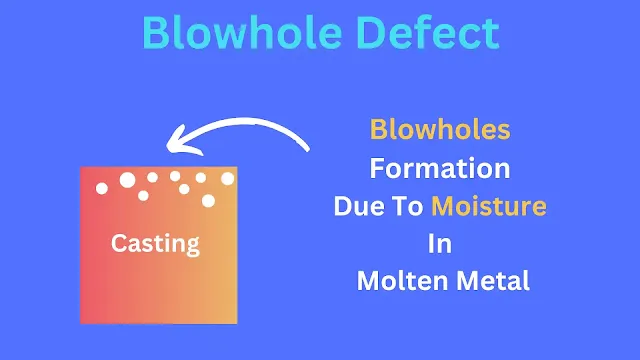
|
| (x) Blowhole |
Blowholes are caused by moisture present in the mould and core that is not able to escape the mould due to insufficient venting and low permeability of the mould.
When molten metal comes in contact with mould with the presence of moisture steam is generated. This steam needs to escape from the mould for proper sound casting.
If mould does not have proper ventilation and sand used in the mould is fine having no space for steam to exit blowholes defects are seen in the casting.
The remedy to eliminate blowholes is to use course large-size grains in combination with fine grain size sand.
The blowhole defect in casting is shown above in diagram (x).
Cores and mould should be properly vented so gasses are escaped properly.
Ramming should not be so hard that gasses get trapped. If possible do casting in drag only for easy escaping gasses in the atmosphere.
This defect is seen more in green sand moulds and less in dry sand moulds.
Blow holes are not visible to the naked eye and are inspected using an X-ray machine.
Blow hole appearance is smooth, small and round shape accumulated in cluster formation.
Open Hole Casting Defect

|
| (y) Openhole Casting Defect |
Open blows are visible surface defects seen on the surface of the casting.
Blowholes are seen inside the casting while open blows are seen in the "open" above the casting surface.
The remedy for open blows is the same as blow holes.
The open-hole defect is shown above in diagram (y).
Shrinkage Depression

|
| (z) Shrinkage Cavity Defect |
Shrinkage depression is a type of shrinkage defect that looks like a recessed area on the final metal casting giving casting poor surface quality.
The shrinkage cavity or shrinkage depression is shown above in diagram (z).
Elephant Skin Casting Defects

|
| Elephant Skin Casting Defect |
Elephant skin defect looks like wrinkles and is irregular on the surface of the casting.
The cause for casting skin defect is due to the temperature difference of molten metal during the solidification process or poor use of quality sand.
Shows above elephant skin casting defect in the casting process.
